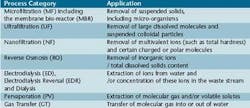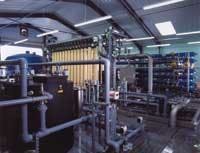Membrane technologyrecovers water for industrial reuse
By Simon Judd, Anthony Bennett
Globally, industrial activity accounts for one quarter of all water consumed. All types of industry use water as an essential input, some using boreholes or surface water, but much of this water is taken from public water supplies treated to potable quality standards.
The United Nations Environment Programme report "Global Environment Outlook 3," prepared prior to the 2002 World Summit on Sustainable Development, held in Johannesburg, South Africa, warned that more than half the world could experience potable water shortages within the next 30 years. Shortages were predicted to affect the Middle East, Asia and the Pacific regions.
Wastewater reclamation can decrease industry's dependence on potable water, thereby increasing the amount of water available for human consumption and alleviating the problem of global shortages.
The economic viability of wastewater reclamation can be complex and dependent on relationships between effluent water quality, purification processes included in the technology solution, and the water quality required by end-users. Wastewater reuse tends to arise from the requirements of environmental legislation or from the related supply and discharge costs. Between 1980 and 1995, the cost of water supply and discharge trebled in the UK and increased by more than an order of magnitude in California.
Membrane categories and applications
Identifying opportunities for the recovery of water for direct reuse without purification is best conducted by water auditing throughout an industrial installation using Water pinch analysis. Many software packages conduct these analyses, and they are becoming increasingly sophisticated. These analytical tools have not yet reached a level of complexity where water purification unit processes can be incorporated, since their performance can rarely be reliably predicted. Industrial effluent quality is subject to wide process-related, diurnal and/or seasonal fluctuations; therefore it is far more advantageous to reduce water demand rather than recycle effluent. Increasing awareness of this fact has led to dramatic reductions in water use over the past 10 years.
The application of recycling (reuse of water for the same or similar duty) normally relies on suitable process technologies for water purification. Wide fluctuations in industrial effluent quality coupled with the requirement for process water of reliable quality tend to favour the application of membrane processes, since these can provide permeate product water of a consistent and reliable high quality.
Three main advantages of membrane processes over conventional techniques are the following:
• Separation is achieved without requiring a change of state (i.e. liquid to gas) and is therefore more energy efficient than, for example, distillation processes.
• Little accumulation takes place in the process, which operates continuously under steady state conditions without requiring regeneration cycles, unlike adsorptive separation processes such as ion exchange.
• Little chemical addition is required, unlike conventional clarification, for example, which generally relies on the addition of coagulants and flocculants.
Membrane types that can be used in industrial water reuse are categorised in Table 1.
Membrane technologies are already established for specific industrial processes where other resources are recovered in addition to water, such as pulp solids in paper manufacturing and paint pigments in electrophoretic painting. Currently, they are generally considered too expensive for wastewater recycling for most industrial processes; however this situation is changing. Advances in membrane technology and significant improvements in its efficiency, and cost effectiveness have greatly increased the competitiveness of recycling over discharging effluent.
Table 2 lists eleven case studies from a broad spectrum of industries that have been analysed in the book Membranes for Industrial Wastewater Recovery and Reuse, co-edited by Cranfield University Professor S J Judd and B Jefferson, and published by Elsevier, UK, in 2003. Throughputs for these installations vary from 140 to 3,750 m3day. Payback times vary from 1.7 years to 5.2 years, although examples exist of payback periods as low as eight months in cases, such as electrophoretic paint recovery, where substantial resource recovery exists in addition to water recovery.
Case studies of industrial wastewater recycling
The Flag Fen Project, established by the Anglian Water Group (AWG) in the UK, is the largest example cited in the table. Undertaken since 1995, the plant incorporates microfiltration (MF) and reverse osmosis (RO) membrane technology. Municipal effluent is re-used and processed into low conductivity water for feeding into the Texas Utilities' Peterborough Power Station, located adjacent to the Flag Fen sewage treatment works (STW). ACWa Services Limited built and installed the plant, and later commissioned the system in summer 2000 (More project details at www.acwa.co.uk).
The major challenge with using sewage effluent as the feed to a high purity treatment plant is the natural variation in its quality, which varies seasonally and diurnally. Flag Fen STW produces an effluent water quality with a mean BOD5 of 10 mg/l, COD of 51.3 mg/l and a total suspended solids concentration of 17 mg/l. The quality is variable with a peak to mean ratio of 3.7 for suspended solids and 3.3 for BOD5. Smaller variations are observed for COD (2.2) and total phosphorus (1.5). Seasonal variations occur due to a vegetable processing factory that discharges varying effluent quality depending on the food being processed.
The permeate quality from both membrane plants was reliable and in line with previous values found from pilot studies. Feed quality to the RO plant can show large variation with rainfall, conductivity can vary between 800 and 1200 µS/cm. Permeate quality from the RO plant is typically 39 µS/cm, representing a rejection of 96.7 % on average. Overall rejection of TDS is 93% with specific rejections of sodium and calcium of 95% and 99% respectively.
Membrane fouling proved to be the main challenge during commissioning. Fouling reduced output from the MF plant and increased pressure on the feed stream of the RO plant. Initial operation of the plant showed excellent water quality but high RO fouling rates. The RO feed pressure increased at a rate of one bar per hour at worst due to rapid build up of calcium phosphate. Changes in upstream operation have effectively controlled the problem and RO membrane cleaning is now typically required every six months.
The Flag Fen plant is currently exceeding the target water qualities set down in the original negotiations. The quality of the delivered water helped increase ultra pure water production at the power station by 20%. Coupled with this is a reduction of over 90% in the costs of ion exchange regeneration due to an increase in the operating cycle of the twin bed demineralisation plant from 8 to 60 hours. These improvements led to savings of 1,250 m3 of potable water per day, which reduced the total water use of the power station by 11%.
The Flag Fen water recycling project is considered a success. The scheme guarantees a water supply at lower operating costs for the power plant. The high purity water plant cost approximately US$ 1.53 million and each membrane stage has an operating cost of US$ 0.11 per m3 permeate produced. The project won three prestigious awards, including the 2000 Water UK/Environment Agency award, the 2001 IChemE Innovation Efficiency award and the 2001 Green Apple award, sponsored by The Green Organisation, an independent UK-based environmental group.
Conclusions
Industrial effluent recycling is technically feasible, but its economic viability depends on imposed regulatory restrictions on supply and discharge combined with the perceived or actual technical and financial risk. The implementation of any reuse scheme requires economic profitability, but this alone does not drive its adoption. Instead, legislative or water scarcity issues are generally cited as being the primary drivers, which then affect economic viability.
All the case studies listed in Table 2 resulted in total payback of initial capital expenditure and have operated successfully over extended periods of time. It remains to be seen whether the UN's predicted scarcity of potable water leads to more widespread membrane technology-based industrial effluent recycling, and the level of sophistication developed both for the water purification process and the waste concentrate management system.
Authors' Note
Simon Judd is a professor and chair in membrane technology at Cranfield University, UK and is co-editor of Membranes for Industrial Wastewater Recovery and Reuse, published by Elsevier, UK. For more information, contact [email protected], or visit www.cranfield.ac.uk/sims/water.
Anthony Bennett is managing and technical director at Specialist Technical Solutions Limited, UK. Contact [email protected], or visit www.specialist-technical-solutions.co.uk




